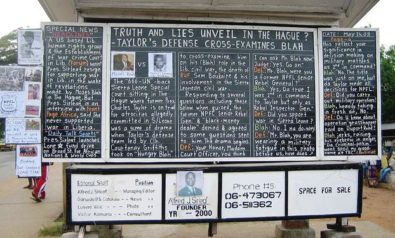
Though the decision to end the civil war in 2002 was certainly a welcome development for Sierra Leone, ten years later challenges still remain in terms of resolution and reconciliation in the country.
Background
The Republic of Sierra Leone as it is now officially called, got its name from the Portuguese explorer Pedro de Sintra who called it ‘Serra Leoa’, meaning ‘lion mountains’, in the 15th century. Centuries of foreign rule ended in 1961 when Sierra Leone became independent after 153 years as a British colony. The first years of independence turned out to be tough and saw a rapid change of leadership caused by various coups and political unrest that eventually turned the country into a one-party state by 1978.
In 1991, the civil war that impacts the country to this day, began. The Sierra Leonean rebel group Revolutionary United Front (RUF) under Foday Sankoh became active with the help of Charles Taylor and his rebel group, the National Patriotic Front of Liberia (NPFL). The RUF was dissatisfied with the government, and Taylor, who was involved in the war in Liberia at that time, was hoping that the diamond fields in Sierra Leone could finance his conduct of war at home.
The Sierra Leone Army (SLA) was not able to stop them and the RUF soon gained control over some important diamond fields. From that point on, the diamond trade funded the RUF while the government was cut off from one of its most important sources of income. These events were accompanied by political instability: dissatisfied with the way that then President Joseph Saidu Momo handled the rebellion, Valentine Strasser ousted him in a coup d’état in 1992. However, another military coup ousted Strasser four years later, and this led to Ahmad Tejan Kabbah becoming elected president. He did not manage to stay in office long though. After the Armed Forces Revolutionary Council overthrew him in 1997, he had to flee to Guinea but returned a year later with the help of foreign forces. While these leadership changes were taking place, the RUF continued its violent attacks and also clashed with the Civil Defense Forces that supported Kabbah. They stopped their attacks in 1999, when under international pressure, Kabbah and the RUF signed the Lome peace agreement, granting the RUF the right to participate in the government. It took three more years to end violence in the country and to completely disarm all rebel groups, and the end of the civil war was officially announced in 2002.
Why is Sierra Leone relevant?
Ten years have passed since the end of the civil war that left deep scars on the country. One step towards closing old wounds had recently been taken and brought the conflict back to the world’s attention: Charles Taylor was found guilty of aiding and abetting war crimes and crimes against humanity by the Special Court for Sierra Leone. Even though this is a step towards justice, the verdict is highly disputed. Moreover, taking those who led and fueled the war to court is not the only challenge Sierra Leone had to face over the last ten years and still has to deal with. It still has to contend with the fact that 50,000 people were killed and 2.6mn displaced. The war left its victims traumatised in a manner which can still be seen today. War crimes were committed by both sides: villages were looted, limbs of victims were hacked off, and children were abducted and used as child soldiers. Official reintegration of combatants into society was completed only two years after the end of the war, and many considered the process insufficient. In a country that has experienced such intense conflict and where perpetrators and victims are often living side-by-side, reconciliation remains one of the main tasks, both for the authorities, and also for the people.
While the world awaits the verdict on Taylor’s crimes, Sierra Leoneans struggle to continue with their daily lives. A successful resolution and reconciliation of this civil war, is crucial for the future development and well being of the country.
For more than 10 years, Fair Observer has been free, fair and independent. No billionaire owns us, no advertisers control us. We are a reader-supported nonprofit. Unlike many other publications, we keep our content free for readers regardless of where they live or whether they can afford to pay. We have no paywalls and no ads.
In the post-truth era of fake news, echo chambers and filter bubbles, we publish a plurality of perspectives from around the world. Anyone can publish with us, but everyone goes through a rigorous editorial process. So, you get fact-checked, well-reasoned content instead of noise.
We publish 2,500+ voices from 90+ countries. We also conduct education and training programs on subjects ranging from digital media and journalism to writing and critical thinking. This doesn’t come cheap. Servers, editors, trainers and web developers cost money.
Please consider supporting us on a regular basis as a recurring donor or a sustaining member.
Support Fair Observer
We rely on your support for our independence, diversity and quality.
Will you support FO’s journalism?
We rely on your support for our independence, diversity and quality.





